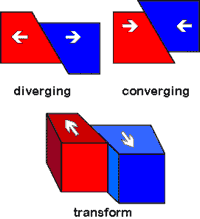BACKGROUND:
Understanding the movement and behavior of the Earth's
outermost layers has been a painstakingly long scientific process. The
theory of plate tectonics is our current "best explanation" and
working model for answering these questions. Plate tectonic theory has
developed slowly and progressively since it was developed in the 1960s. It
is a theory that truly has the entire world as its experiment.
Scientific ideas are subject to change as new
information is gathered. This is why there are no "facts" in
science. Every interpretation can be improved upon and altered as new
research is completed. Scientific interpretations are continually tested and
updated.
In this lab, students will test plate tectonics
against two other hypotheses: 1) the Earth is expanding in size, and 2) the
Earth is contracting in size. Both of these are real hypotheses proposed by
earth scientists. They are not accepted, because, as the students will see,
they do not accurately explain the behavior of the Earth’s crust.
This lab focuses on testing the ability of each of
ideas to explain the stresses observed in the plates (especially the crust).
Three types of stress are common. Compression is when a squeezing force is
applied to a rock. Compression or converging plates builds mountains, which
often occur in parallel ranges, with valleys between them. Diverging plates
or extension is a when a pulling apart force effects a rock; it is the
opposite of compression. Diverging also creates sets of parallel valleys.
Transform motion along plate boundaries produces a shearing force is when
two forces are applied to a rock, but in parallel and opposite directions.
In the lab, the students will discover that a
contracting Earth only produces converging and that an expanding Earth
creates only diverging. Only plate movement can produce all three types of
motion.
PROCEDURE:
 Review
the types of motion that are common in the Earth’s crust. Make sure
the students understand the differences between stress caused by
converging, diverging, and transform.
Review
the types of motion that are common in the Earth’s crust. Make sure
the students understand the differences between stress caused by
converging, diverging, and transform.
- Have the students work with a lab partner. Demonstrate lab procedures
to the class before they begin to work. Emphasize to the students that
the experiments should be done slowly. Also emphasize that they should
carefully observe the types of stress created in each experiment, and
why they occur. Make sure they record their findings on the worksheet.
- For theory 1 and 2 students use the flour mixture to simulate the
lithosphere (crust and upper mantle) moving on top of the balloon (asthenosphere).
Students can try to be realistic about making continents out of the
flour mixture. In the expanding Earth, the flour mixture will move
apart, making cracks and wrinkles that are parallel. The contracting
earth will have the lithosphere moving together causing parallel
mountains and valleys. Plate tectonics will also give you parallel
features.
- For theory 3, the arrows indicate the direction of pressure. In 1, the
students demonstrate compression. They should first squeeze a piece of
aluminum foil with equal pressure from both hands, and then with one
hand exerting more pressure. In 2, the students experiment with shear.
They should move one hand diagonally down while the other hand goes
diagonally up. This is similar to movement on the San Andreas Fault in
California. 3 and 4 represent a more realistic models of the Earth where
different densities of respond differently to stress. Key observations
are the creation of parallel mountains and valleys.
- When they are finished, review the students’ findings. Focus on
Theory 3 (Plate Tectonics) so that they get an understanding of mountain
building, earthquakes, and volcano formation as they relate to crustal
movement. There are many reasons why the contracting and expanding Earth
theories are not good explanations. They do not fit all the data that
geologists have accumulated over the years. Geologists can measure the
Earth's diameter, and the Earth does not seem to have gotten larger nor
smaller. Students should discuss various tests. Even if they come up
with some silly answers, it gets them thinking about the pros and cons
of the different models.